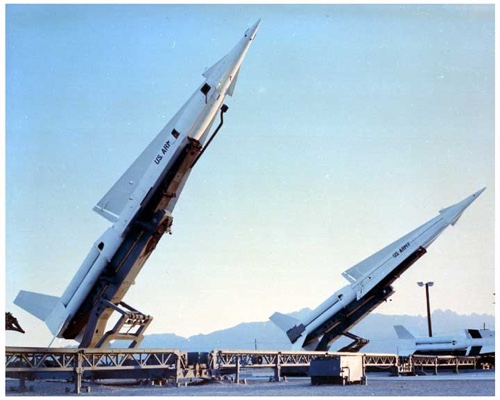What Happens to Old Military Weapons We No Longer Need?

Nike-Hercules missiles
Nike is back.
Not the athletic wear company based in Oregon, but the U.S. Army antiaircraft missile named (like other army Cold War missiles) after a Greek god. And, the Nike is not back in the military’s inventory, but rather it has curiously surfaced again in American culture.
 Sixty years ago, defense leaders
feared the Soviet Union might attack U.S. cities and defense
installations with large numbers of high-flying bombers laden with
nuclear weapons. In the atomic era, for the many who were mindful of
the urban devastation wrought by bombers in World War II, this was an
especially alarming prospect. As a consequence, the Army
developed the Nike-Hercules antiaircraft missile and its two-kiloton
warhead. Eventually, about 2500 were
positioned at 123 launch sites around 26 cities and 10 Air Force
bases in 25 states. The weapon’s aerial nuclear blast (larger than
that produced by conventional explosives) was meant to increase
the likelihood of destroying attacking planes; a “kill probability”
that was not otherwise possible with prevailing technology. As
preposterous as such defenses might seem by today’s
standards, officials thought they made sense at the time, and worked
to ensure the missiles (and companion arms assigned to the Air Force)
were designed and deployed as safely as possible.
Sixty years ago, defense leaders
feared the Soviet Union might attack U.S. cities and defense
installations with large numbers of high-flying bombers laden with
nuclear weapons. In the atomic era, for the many who were mindful of
the urban devastation wrought by bombers in World War II, this was an
especially alarming prospect. As a consequence, the Army
developed the Nike-Hercules antiaircraft missile and its two-kiloton
warhead. Eventually, about 2500 were
positioned at 123 launch sites around 26 cities and 10 Air Force
bases in 25 states. The weapon’s aerial nuclear blast (larger than
that produced by conventional explosives) was meant to increase
the likelihood of destroying attacking planes; a “kill probability”
that was not otherwise possible with prevailing technology. As
preposterous as such defenses might seem by today’s
standards, officials thought they made sense at the time, and worked
to ensure the missiles (and companion arms assigned to the Air Force)
were designed and deployed as safely as possible.
None of this was a secret. Among other things, news releases touted the missiles, they were featured on cereal box trading cards (“the most effective surface-to-air weapon in America’s Arsenal of air defense” declared NABISCO shredded wheat), and trotted out in local parades. The soldiers assigned to the launch sites also explained their responsibilities to audiences in the suburban and rural communities in which they were located. Indeed, television journalist Sam Donaldson got his professional start as a young Army public affairs lieutenant when he described the Nike defenses during a program on Texas’ KROD in 1958.
After the missiles were removed and the last Nike emplacements were shuttered between 1974 and 1979, the abandoned parcels dotting the country became parks, schools, and industrial sites. Although often their original purpose was forgotten or misremembered in subsequent decades, they became mysterious symbols of an uncertain past. Harlan Corben, the bestselling novelist who the New York Times calls “folk poet of the suburbs,” makes a Nike site central to “Don’t Let Go,” his latest of thirty thrillers released by Dutton on September 26. “The legend that inspired this book,” Corban writes in the preface, was the existence (“behind barbed-wire fencing and official no trespassing signs”) of a Nike missile emplacement with “nuclear capabilities” in his hometown of Livingston, New Jersey. Corben recently returned to that site with a Times reporter in tow. The resulting story recounted the details of New York City’s Nike defenses.
Nikes apparently play a role in Bart Simpson’s life, too. October 1 marked the start of the animated satire’s 29th year on television. The executive producer recently described the season premiere; it “begins with Bart getting lost in an abandoned Nike missile station from the 1960s.” In 1961, Timmy and his canine companion had a similar experience in a Lassie episode. They were driven through an active Nike site as an attentive soldier described the weaponry.
Fifty-six years later, it seems that as new nuclear threats have supplanted long passed fears of Soviet air attack, what was once a cutting-edge defense technology remains a curious subject for some. Nuclear air defense weapons once comprised about 20 percent of the U.S. atomic arsenal. Now they are but a historical footnote, despite the fact their physical remains still spark published mysteries and televised cartoons. When Nike sites were first constructed, no one probably foresaw this outcome. Which leads to a question: what parts (if any) of U.S. defense infrastructure will survive a half century, dismantled and unused for its intended purpose, but persistently visible someway in American culture?